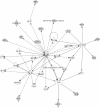LDL-cholesterol signaling induces breast cancer proliferation and invasion
- PMID: 24428917
- PMCID: PMC3896822
- DOI: 10.1186/1476-511X-13-16
LDL-cholesterol signaling induces breast cancer proliferation and invasion
Abstract
Lipids and cholesterol in particular, have long been associated with breast cancer (BC) onset and progression. However, the causative effects of elevated lipid levels and breast cancer remain largely undisclosed and were the subject of the present study.We took advantage of well-established in vitro and in vivo models of cholesterol enrichment to exploit the mechanism involved in LDL-cholesterol favouring BC growth and invasiveness. We analyzed its effects in models that mimic different BC subtypes and stages.Our data show that LDL-cholesterol (but not HDL-cholesterol) promotes BC cells proliferation, migration and loss of adhesion, hallmarks of the epithelial to mesenchymal transition. In vivo studies modeling cholesterol levels showed that breast tumors are consistently larger and more proliferative in hypercholesterolemic mice, which also have more frequently lung metastases. Microarray analysis revealed an over expression of intermediates of Akt and ERK pathways suggesting a survival response induced by LDL, confirmed by WB analyses. Gene expression analysis also evidenced an activation of ErbB2 signaling pathway and decreased expression of adhesion molecules (cadherin-related family member3, CD226, Claudin 7 and Ocludin) in the cells exposed to LDL.Together, the present work shows novel mechanistic evidence that high LDL-cholesterol levels promote BC progression. These data provide rationale for the clinical control of cholesterol levels in BC patients.
Figures





References
-
- Swyer G. The cholesterol content of normal and enlarged prostates. Cancer Res. 1942;2:372–375.
Publication types
MeSH terms
Substances
LinkOut - more resources
Full Text Sources
Other Literature Sources
Medical
Molecular Biology Databases
Research Materials
Miscellaneous

